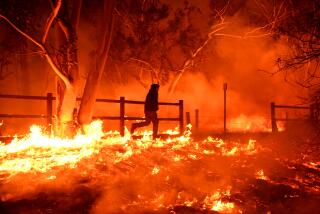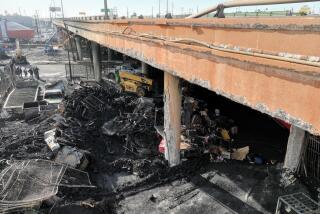Aging DWP equipment is a risk for sparking wildfires, L.A. city controller warns
Los Angeles City Controller Ron Galperin released an audit this week that urges the Department of Water and Power to speed up repairs of utility equipment to reduce the risk of sparking wildfires.
The report listed 50 transformers in fire hazard zones that the DWP had identified for replacement as of August.
The report also identified 2,230 utility poles that the DWP had selected for replacement in such zones. But on Wednesday, the utility said the correct number was 30.
Galperin questioned that assertion during a news conference at City Hall. He said that his office worked with the DWP for six months on the audit and that the utility changed the number shortly before the report’s release.
“They repeatedly gave us information — information that was consistent and information that they said was accurate. Then, at the 12th hour, they come up with a very different number,” Galperin told reporters.
DWP spokesman Joe Ramallo said a data error led to the change. He also said the backlogs cited in the city’s audit are for “pending” work to replace aging transformers and utility poles, not for work that hasn’t been addressed on time.
“If a pole is out of compliance with regulatory standards, it is replaced immediately,” Ramallo said. “This was not explained clearly in the report.”
In state-designated fire hazard areas, which are different from those designated by the Los Angeles Fire Department, the report found that 824 utility poles were identified for replacement as of August. The zones overlap in some cases, but there was no double counting of poles, according to the controller’s office.
Utilities across the state have faced increased risk and liability as California’s fire season grows longer and deadlier. Under state law, a utility company must pay for damage to homes and property if its power equipment causes a fire, even if there was no negligence on the part of the utility.
Some companies have decided to turn off power during windy red flag conditions to reduce the risk of equipment sparking a fire, but the DWP has chosen not to do so. Instead, the utility has carried out fire prevention measures such as clearing vegetation around its power lines and replacing aging equipment.
The Getty fire last month is believed to have started when a dried eucalyptus tree branch broke off during high winds, hitting a DWP power line. Sparks ignited a brush fire that destroyed 12 homes and forced thousands of residents to evacuate.
The DWP is expected to face an average of $42 million in annual losses over the next 100 years because of the threat of fires, according to the report. The utility has wildfire insurance but says its premiums have risen 20% in the last few years.
Galperin’s 37-page review of the DWP’s wildfire prevention strategies focused in part on the utility’s backlog of replacing power poles and equipment that could fuel blazes. The controller’s office calls for the utility to work closely with the LAFD to better evaluate vegetation and other fire dangers in high-risk areas and consider creating a wildfire insurance fund for publicly owned power utilities.
More to Read
Start your day right
Sign up for Essential California for news, features and recommendations from the L.A. Times and beyond in your inbox six days a week.
You may occasionally receive promotional content from the Los Angeles Times.







